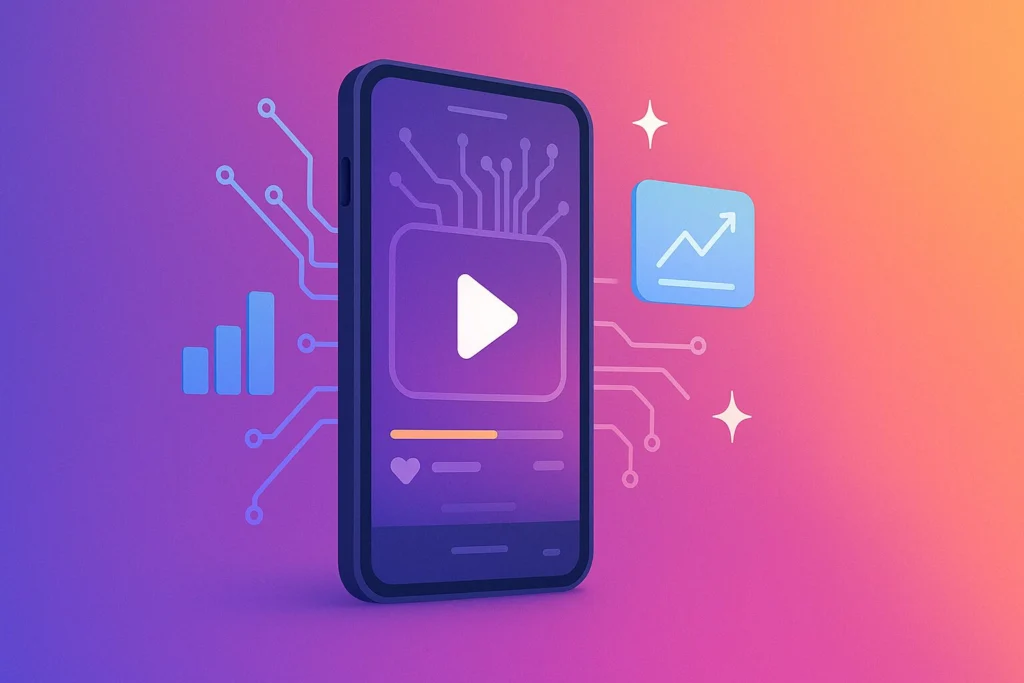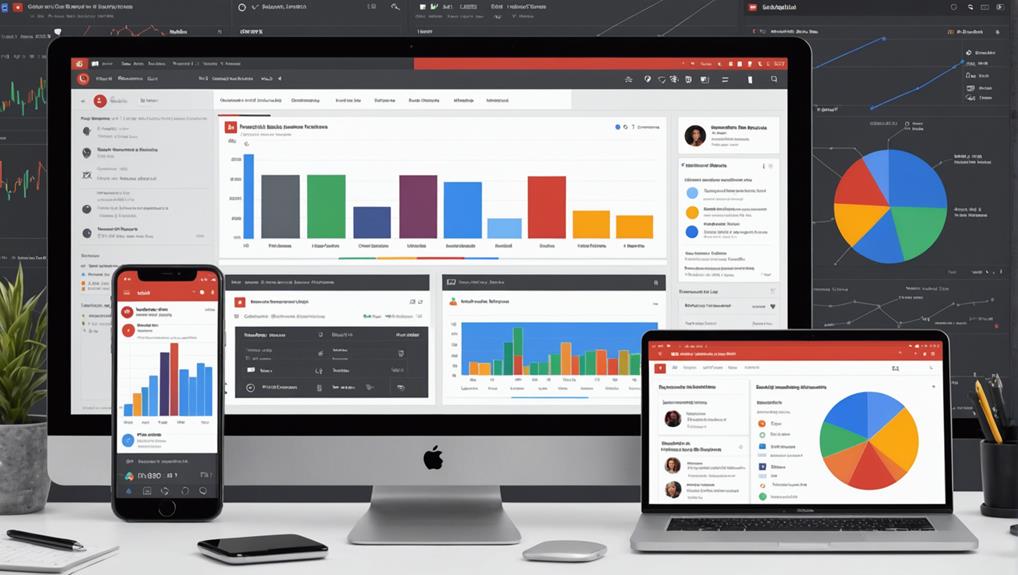To create effective YouTube ad campaigns, start by researching your target audience using tools like Google Analytics and YouTube Analytics. Craft compelling video content that grabs attention and includes clear calls-to-action. Set up your YouTube channel with consistent branding and connect it to Google Ads for advanced targeting. Employ strategic bidding strategies, such as CPV or Maximize Conversions, and select the right ad formats for your goals. Continuously optimize ad performance by monitoring metrics and making data-driven adjustments. Measure campaign success using key metrics like view counts and conversion rates to fine-tune your strategy. Discover more by exploring these crucial steps in detail.
Key Takeaways
- Conduct thorough audience research using tools like Google Analytics to understand demographics and preferences.
- Create engaging videos with compelling narratives and clear calls-to-action to capture and retain viewer attention.
- Link your YouTube channel with Google Ads for enhanced targeting and data-driven campaign optimization.
- Choose ad formats like In-Feed, Bumper, or In-Stream ads based on campaign goals and audience engagement.
- Continuously monitor key performance metrics such as CTR and conversion rates to refine and optimize ad campaigns.
Research Your Target Audience
To create effective YouTube ad campaigns, start by conducting thorough audience research to understand their demographics, interests, and behaviors. Utilize tools like Google Analytics and YouTube Analytics to gain detailed insights into who your audience is and what they care about. These platforms provide valuable data on age, gender, location, and viewing habits, allowing you to tailor your ads precisely.
Understanding behavior is essential. Look into the types of content your audience interacts with the most. Are they watching product reviews, tutorials, or entertainment videos? This information helps you align your ad's message and format with their preferences, increasing the likelihood of engagement.
Next, analyze competitors to gain further insights on audience preferences. Identify key competitors in your niche and study their successful campaigns. What kind of content are they producing? What audience segments are they targeting? Assess their strategies to uncover gaps or opportunities that you can capitalize on.
Refine your targeting options based on these insights. Segment your audience into specific groups and customize your ad delivery to each segment. This targeted approach ensures that your ads reach the right people at the right time, maximizing your campaign's effectiveness.
Craft Compelling Video Content
To craft compelling video content:
- Grab your audience's attention within the first few seconds by addressing their specific needs or interests.
- Utilize data-driven insights to guarantee your narrative resonates.
- Include a clear call-to-action that guides viewers on what to do next.
- Test different formats and styles to pinpoint what keeps your audience engaged and drives conversions.
Grab Attention Quickly
Grabbing your audience's attention within the first 8 seconds of a YouTube ad is vital, given that 65% of viewers skip ads after just 5 seconds. To combat this, focus on emotional storytelling and visual storytelling. Start by crafting a compelling narrative that tugs at the heartstrings or provokes thought.
Research shows that videos evoking emotions in the first 10 seconds are more likely to resonate and increase ad recall.
Use eye-catching visuals right from the start. Engaging imagery can hook viewers immediately and keep them engaged. Studies highlight that ads with strong visual appeal in the initial moments have a higher retention rate.
Whether it's an unexpected scene, vibrant colors, or an intriguing visual effect, make sure your visuals are designed to make an impact.
Utilizing humor, shock value, or a compelling narrative can also play an important role. Strategic planning and understanding your target audience's preferences will help you decide which emotional triggers and visuals to use.
Clear Call-to-Action
Incorporating a clear call-to-action within your YouTube ad provides viewers with a definitive next step, greatly enhancing the likelihood of engagement and conversion. Data shows that ads with a well-defined call-to-action (CTA) greatly improve conversion rates, transforming passive viewers into active participants.
To craft an effective CTA, focus on what action you want your audience to take—whether it's subscribing to your channel, visiting your website, or making a purchase.
Audience engagement is vital. Your CTA should be concise, compelling, and seamlessly integrated into your video content. For instance, if your ad promotes a new product, a CTA like 'Click to Buy Now' or 'Learn More on Our Website' can drive immediate action. Use action-oriented language that resonates with your target demographic and aligns with their needs and interests.
Strategically placing your CTA at key moments in the video can also boost effectiveness. Whether it's at the beginning, middle, or end, make sure it's visible and easy to follow. By providing a clear next step, you not only enhance audience engagement but also increase your campaign's overall success.
Set Up Your YouTube Channel
Connecting your YouTube channel with your Google Ads account is essential for running successful ad campaigns and ensuring all your marketing efforts are streamlined. To set up your channel effectively, focus on maintaining branding consistency and projecting a professional image. This foundational step enhances your credibility and makes your content more relatable to your target audience.
Start by ensuring your channel's visuals and messaging align with your brand. Use your logo, brand colors, and consistent tone across all content. This not only reinforces your brand identity but also builds trust with viewers.
Channel Art: Create a banner that showcases your brand and communicates your channel's purpose.
Profile Picture: Use a high-quality image, preferably your logo, to maintain a professional look.
About Section: Write a compelling description that reflects your brand's mission and values.
Additionally, your audience targeting method is vital. Identify who you want to reach and tailor your content to their interests and needs. Engaging and meaningful content is key to attracting and retaining viewers.
Lastly, always include a clear call to action in your videos. This prompts viewers to subscribe, visit your website, or interact with your brand, driving further engagement and conversions.
Link Google Ads Account
Connecting your Google Ads account with your YouTube channel is essential for leveraging advanced targeting options and optimizing your ad campaigns. By linking your accounts, you'll access a variety of account linking benefits that enhance your campaign's performance. This integration enables seamless ad management, giving you the ability to set up and control YouTube ad campaigns directly from Google Ads.
The integration advantages are considerable. You'll gain access to advanced targeting options and detailed analytics, allowing for better data tracking and consistent optimization. This guarantees that your ad spend is utilized more effectively, leading to a higher return on investment (ROI). Additionally, the streamlined process of running ads and tracking results means you can make real-time adjustments to improve performance.
Moreover, linking your accounts allows for more precise targeting. You can leverage YouTube's extensive data to reach specific audiences based on their viewing habits, interests, and demographics. This strategic approach means your ads are shown to the right people at the right time, maximizing engagement and conversion rates.
To conclude, the seamless integration of your Google Ads account with your YouTube channel is a strategic move that significantly enhances your ad campaign's success.
Choose Bidding Strategies
When choosing your bidding strategy, consider whether a Cost-per-view (CPV) or Maximize Conversions tactic aligns best with your goals.
Analyze data on your target CPA (Cost per Acquisition) to make sure you're optimizing ROAS and controlling costs effectively.
Start with a $10 daily investment to test these strategies and adjust based on performance metrics.
Cost-Per-View Selection
Selecting the appropriate Cost-Per-View (CPV) bidding strategy on YouTube is crucial for optimizing your ad spend and reaching your campaign's brand awareness goals. By focusing on bid optimization and cost analysis, you can guarantee that your budget delivers the maximum possible impact. CPV bidding typically ranges from $0.05 to $0.15 per view, and setting a maximum CPV bid allows you to control costs and optimize for views effectively.
CPV bidding is especially beneficial for video ads aimed at increasing brand awareness and engagement. By paying only when viewers watch a certain percentage of your ad, you can ensure that your investment directly correlates with audience interaction. Adjusting your CPV bids based on campaign performance and audience behavior will help you fine-tune your strategy for even better results.
Key considerations for CPV bidding include:
- Bid optimization: Regularly adjust bids to maximize viewability while staying within budget.
- Cost analysis: Continuously monitor spending to make sure you're achieving desired engagement levels at a cost-effective rate.
- Performance tracking: Use analytics to identify high-performing segments and adjust your strategy accordingly.
Maximize Conversions Tactic
To maximize conversions, you need to choose between Cost-per-view (CPV) and Cost-per-click (CPC) bidding strategies based on your specific campaign goals. CPV bidding charges you when viewers watch at least 30 seconds of your ad or engage with it, making it vital for brand awareness and detailed messaging. Typically, CPV costs range from $0.10 to $0.30 per view.
On the other hand, CPC bidding charges you for clicks on the ad, which is more suitable for driving traffic to your website. The cost for CPC can vary greatly depending on competition and targeting parameters. By focusing on CPC, you can directly influence user actions and website visits.
Choosing the right strategy is essential for effective ad optimization and achieving your campaign objectives. Use conversion tracking to measure which strategy yields better results for your specific goals. For instance, if higher website traffic leads to more sales, CPC might be your best bet. Conversely, if you're aiming for greater brand awareness, CPV could provide better returns.
Incorporate these bidding strategies wisely to maximize conversions, and continuously monitor performance to adapt and optimize your campaigns effectively.
Target CPA Strategy
Understanding the Target CPA strategy allows you to establish a cost-per-acquisition goal, guaranteeing your ad spend aligns with your business's financial objectives. This bidding approach automates your bids to achieve conversions at or below your set target CPA, making it a powerful tool for conversion optimization. By focusing on acquiring customers within a specific budget, you're maximizing your ROI.
To effectively use the Target CPA strategy, consider the following:
- Performance tracking: Regularly monitor your campaign's performance to confirm it meets your CPA goals.
- Ad budgeting: Set a realistic budget that supports your target CPA without overspending.
- Targeting refinement: Continuously refine your audience targeting to enhance conversion rates.
Target CPA bidding ensures that your ads are delivered strategically, optimizing for conversions while keeping costs in check. It requires a deep understanding of your business objectives and the value of each conversion. With proper performance tracking, you can make data-driven decisions that enhance your campaign's effectiveness.
Select Ad Formats
Selecting the appropriate YouTube ad format is essential for maximizing your campaign's reach and effectiveness. Start by considering ad placement and ad duration. In-Feed ads, appearing as sponsored videos in the homepage feed or search results, are ideal for grabbing attention during browsing.
For short, impactful messages, Bumper ads offer a non-skippable 6-second format that guarantees your message is seen without overwhelming the viewer.
Audience engagement is vital, and In-Stream ads provide flexibility. Skippable In-Stream ads let viewers skip after 5 seconds, giving you a chance to capture interest quickly. Non-Skippable In-Stream ads, on the other hand, guarantee full ad viewing but should be used sparingly to avoid viewer frustration.
Overlay ads, appearing as semi-transparent banners at the bottom of videos, are perfect for subtle engagement and linking directly to your website.
Ad customization can further enhance effectiveness. Tailor your ads to fit the chosen format and audience preferences. For instance, a compelling call-to-action in an Overlay ad or an engaging first 5 seconds in a Skippable In-Stream ad can greatly boost engagement.
Strategically selecting and customizing your ad formats ensures top impact and a successful YouTube ad campaign.
Optimize Ad Performance
Once you've selected the right ad formats, it's essential to monitor and optimize your ad performance to ensure maximum impact and ROI. Start by diving into YouTube's analytics tools to conduct a thorough performance analysis. Track key performance indicators (KPIs) like click-through rate (CTR) and conversion rate to understand how your ads are performing.
Make data-driven decisions by using A/B testing to compare different ad elements such as headlines, visuals, and calls to action. This helps identify what resonates best with your audience. Adjust your targeting parameters based on audience behavior and engagement data. You'll want to continuously refine your approach for best results.
Consider these strategies:
- Monitor Metrics: Keep a close eye on CTR, conversion rates, and other KPIs.
- A/B Testing: Experiment with various headlines, visuals, and CTAs to see what works best.
- Adjust Targeting: Fine-tune your targeting based on real-time engagement data.
Measure Campaign Success
To measure campaign success effectively, track key metrics like view counts, click-through rates, and conversion rates. These metrics offer a snapshot of your ad's immediate impact and help you evaluate its reach and appeal.
Begin by analyzing metrics using tools such as Google Analytics and YouTube Analytics. These platforms provide detailed insights into your audience's behavior, enabling you to track engagement through metrics like watch time, likes, comments, and shares.
It's essential to monitor your Return on Ad Spend (ROAS) to gauge the financial effectiveness of your campaign. A high ROAS indicates that your investment is paying off, while a low ROAS suggests the need for strategic adjustments. Regularly review these data points to make sure you're meeting your campaign goals.
Adjust targeting, messaging, and ad creative based on the insights gathered. For instance, if you notice high view counts but low conversion rates, consider refining your call-to-action or targeting a different audience segment.
Frequently Asked Questions
How to Create an Effective Youtube Ad?
To create an effective YouTube ad, focus on audience targeting through detailed research. Invest in professional production, link your channel with Google Ads, and plan your budget strategically to maximize reach and impact.
How Can You Create Video Ads to Maximize Effectiveness on Youtube?
To maximize YouTube ad effectiveness, keep video length short and engaging. Use precise audience targeting to guarantee relevance. Continuously test and refine your strategy based on data-driven insights to optimize viewer engagement and conversion rates.
How Do I Optimize My Youtube Ad?
To optimize your YouTube ad, focus on audience segmentation and keyword targeting. Use demographics and affinity audiences to refine your reach, and monitor performance metrics like click-through rates for data-driven adjustments and strategic planning.
Which Type of Youtube Ad Is Most Effective?
To determine the most effective YouTube ad, consider your ad placement and budget planning. In-Stream ads are generally effective, but Bumper ads and In-Feed ads offer high engagement. Assess your target audience and campaign goals strategically.
Conclusion
By thoroughly researching your target audience, crafting compelling video content, setting up your YouTube channel, and linking your Google Ads account, you've laid a solid foundation.
Choosing the right bidding strategies and ad formats guarantees that your ads reach the right viewers.
Continuously optimizing ad performance and measuring campaign success will keep your strategy data-driven and audience-focused.
With these steps, you're well-equipped to create effective YouTube ad campaigns that drive results and maximize ROI.




